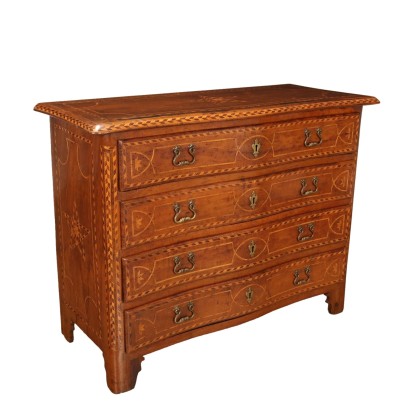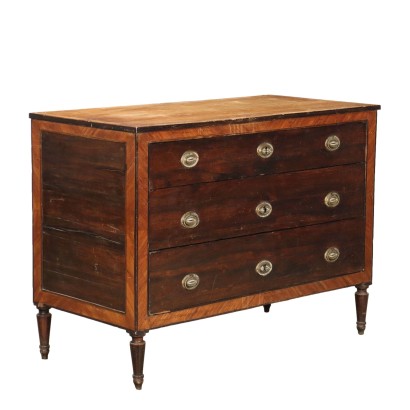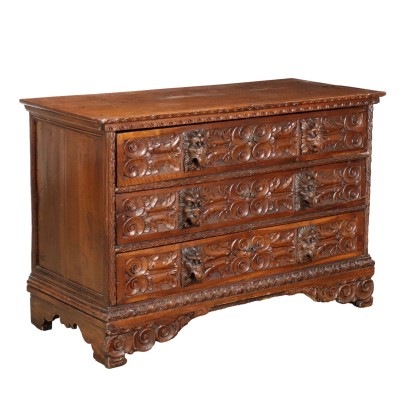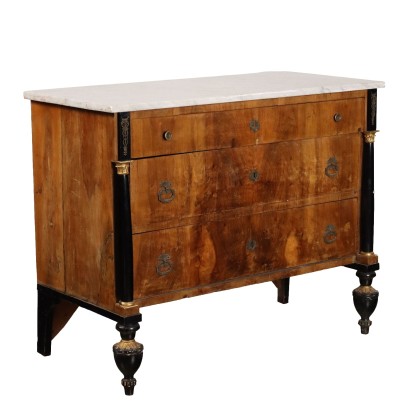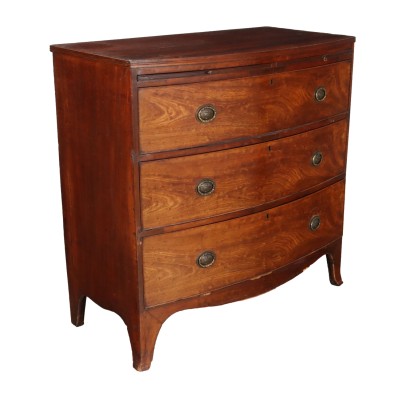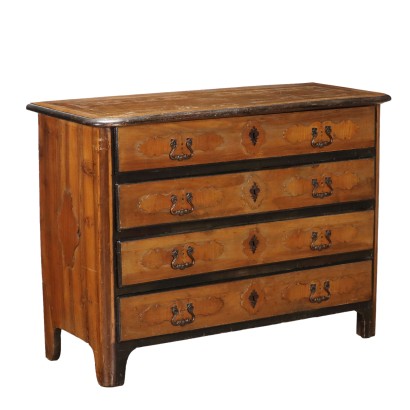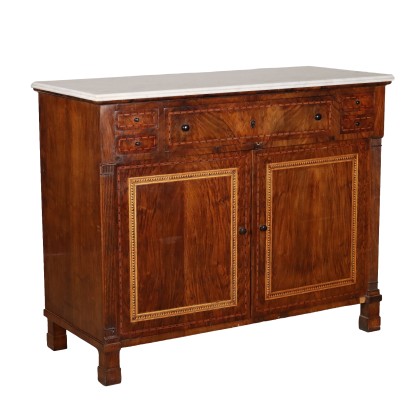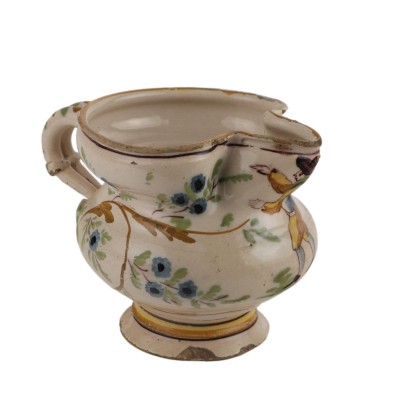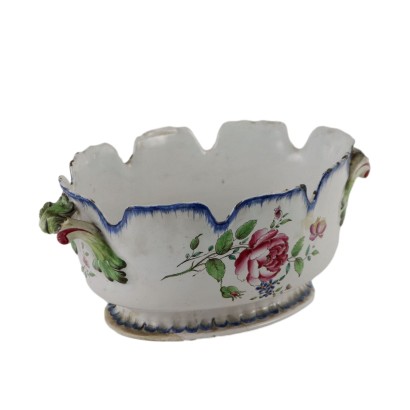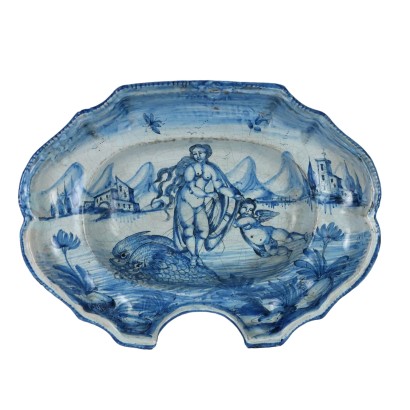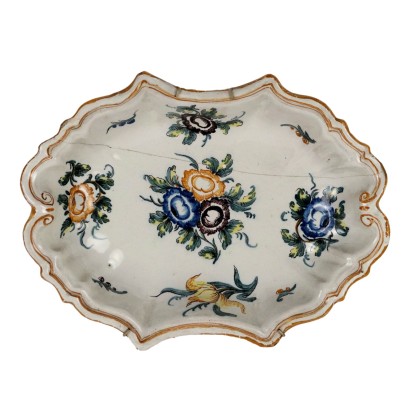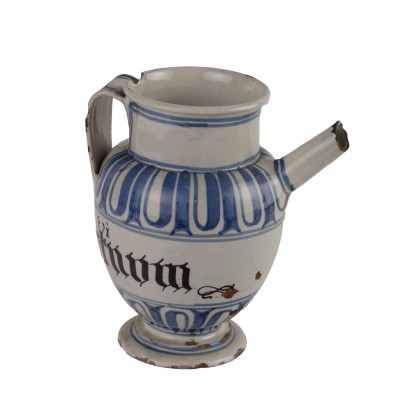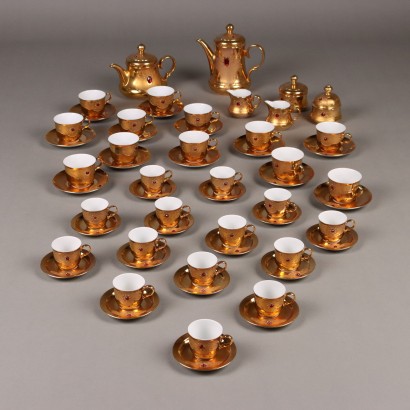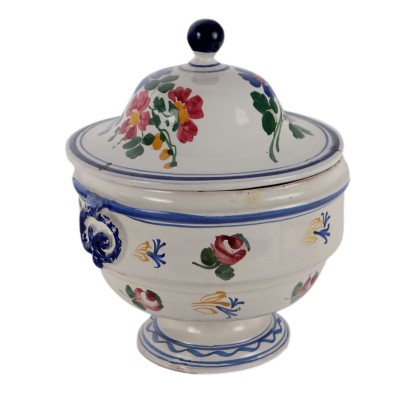Antique Chest of Drawers Louis XVI Poplar Italy XVIII Century - Piedmont, Late XVIII Century
Features
Piedmont, Late XVIII Century
Style: Louis XVI (1774-1792)
Age: 18th Century / 1701 - 1800
Origin: Piemonte, Italy
Main essence: Silver Fir , Pear Wood , Poplar
Description
Piedmontese Louis XVI chest of drawers in pear wood, curved front with four drawers, inlays and fillets in maple and walnut along the entire surface. Sides and upper surface embellished with a five-pointed star. Interior in fir, back in poplar. It has been restored, handles and locks replaced. Piedmont, third quarter of the 18th century
Product Condition:
Product that due to age and wear requires restoration and polishing. We try to present the real condition of the furniture as completely as possible with the photos. If some details are not clear from the photos, what is reported in the description is valid.
Dimensions (cm):
Height: 103
Width: 136
Depth: 57,5
Additional Information
Style: Louis XVI (1774-1792)
The Louis XVI style precedes by many years the coming to the throne of the sovereign from which the name derives.The renewed prevalence of the composure of geometric shapes that characterize the furniture of the neoclassical era, is welcomed as an antidote to the freer and more capricious formulations imposed by the Rococo dictates.
The artist's imagination works free interpretations derived from examples of the Greek-Roman, Etruscan or Egyptian world, from which only the architectural metrics are re-proposed with strict observance.
In this sense, it should be noted that only starting from the 1970s and 1980s in cabinet making did we witness the sunset of the pictorial flowering in inlay, in favor of models with a prevalence of geometric ornamentation.
Therefore, furniture characterized by extreme elegance and virile austerity matures.
In Italy, the Louis XVI style finds natural diffusion.
The furniture tends in the norm since the Sixties-Seventies to adopt a linear structure with a strong presence of decorations.
The use of light brown-colored woods is preferred, such as cherry.
The Italian Louis XVI will always remain linked to the production of furnishing accessories specifically oriented to the inlay typology.
These are furniture of well-proportioned dimensions, supported by the characteristic truncated conical pyramid legs, dressed in the mirrors of the top, sides and panels centered by elegant geometric decorations.
Age: 18th Century / 1701 - 1800
18th Century / 1701 - 1800Main essence:
Silver Fir
Soft coniferous wood, used for rustic furniture or to build the chest, that is the structure, of furniture then veneered in more precious woods. It has been used since ancient times, its most valuable use is, in the Spruce variant, in the inlays of French antique furniture of the '700 . The spruce, more typical of northern Europe, in Italy grows mainly in the Eastern Alps at altitudes above 1300 m. The noblest use of this essence was in the construction of violins, guitars and cellos: Stradivari himself produced his famous violins with this wood.Pear Wood
Hard wood, with a smooth pinkish grain. Used mainly for the construction of country furniture and secondarily for carvings. It was often dyed glossy black to mimic and replace ebony in veneersPoplar
Essence considered "poor", it is a white wood, with yellowish or greyish shades, light and tender, which is easily damaged. It is used for rustic furniture or in the construction of furniture. The most valuable use it has had in the history of furniture is in Germany, in the 19th century, for veneers and inlays in the Biedermeier period.Other customers have searched:
Cassettiera, cassettone, settimanale, mobile da camera, commode, canterano, comò..
Approfondimenti
Scopri di più su cassettiere e comò grazie ai nostri approfondimenti:
La storia nascosta in due antichi cassettoni
Conoscere il Neoclassicismo attraverso un cassettone piacentino
Un comò piemontese influenzato dal fascino per l'Oriente
Un signorile comò rococò napoletano
Una caratteristica cassettiera con alzata emiliana di perfetto gusto barocchetto
E per gli appassionati dal gusto più raffinato, c'è FineArt:
Commode a tre cassetti G.B.M., inizio XIX secolo
Canterano dipinto
Canterano emiliano, primo quarto XVIII
Cassettone a ribalta romano, secondo quarto XVIII secolo
Comò attribuito a Luigi Viglione, Luigi XVI, fine XVIII, Torino
Coppia di comò e comodino di Maggiolini
Sull'antiquariato in generale dai un'occhiata anche a
Classic Monday: da un pezzo dei nostri magazzini alla storia dell'antiquariato
L'antiquariato dalla A alla Z: il Dizionario dell'Antiquariato
Il dizionario dell'antiquariato - Lastronatura
Il dizionario dell'antiquariato - Mascherone
Il dizionario dell'antiquariato - Natura morta
Il dizionario dell'antiquariato - Opificio
Il dizionario dell'antiquariato - Pastiglia
Il dizionario dell'antiquariato - Savonarola
Il dizionario dell'antiquariato - Rosone
Approfondimenti
Scopri di più su cassettiere e comò grazie ai nostri approfondimenti:La storia nascosta in due antichi cassettoni
Conoscere il Neoclassicismo attraverso un cassettone piacentino
Un comò piemontese influenzato dal fascino per l'Oriente
Un signorile comò rococò napoletano
Una caratteristica cassettiera con alzata emiliana di perfetto gusto barocchetto
E per gli appassionati dal gusto più raffinato, c'è FineArt:
Commode a tre cassetti G.B.M., inizio XIX secolo
Canterano dipinto
Canterano emiliano, primo quarto XVIII
Cassettone a ribalta romano, secondo quarto XVIII secolo
Comò attribuito a Luigi Viglione, Luigi XVI, fine XVIII, Torino
Coppia di comò e comodino di Maggiolini
Sull'antiquariato in generale dai un'occhiata anche a
Classic Monday: da un pezzo dei nostri magazzini alla storia dell'antiquariato
L'antiquariato dalla A alla Z: il Dizionario dell'Antiquariato
Il dizionario dell'antiquariato - Lastronatura
Il dizionario dell'antiquariato - Mascherone
Il dizionario dell'antiquariato - Natura morta
Il dizionario dell'antiquariato - Opificio
Il dizionario dell'antiquariato - Pastiglia
Il dizionario dell'antiquariato - Savonarola
Il dizionario dell'antiquariato - Rosone
Product availability
The product can be seen at Milan
Immediate availability
Ready for delivery within 2 working days from ordering the product.



